Protecting and restoring Ann Arbor's natural areas and fostering an environmental ethic among its citizens.
Volume 22, Number 4
Winter 2017
Park Focus: The Ponds Park
Katie Carlisle, Outreach Assistant
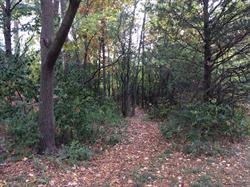
The new trail at The Ponds Park
People feel many different ways about the beginning of winter. If you are like me, you look forward to the first snowfall every year. I enjoy putting on my warmest layers, filling up a thermos with hot chocolate, and exploring the outdoors. It does not get much more peaceful than gently falling snow in the quiet woods. Sometimes, the only sound you can hear is the crunch of the snow under your boots and the blue jay calling from a far-off tree.
If you prefer to stay indoors in winter, you might be lucky enough be one of the people who have a park in their backyard. With over 150 parks in Ann Arbor, quite a few people can appreciate nature through their window without venturing into the cold outdoors.
I have a genuine appreciation for the small neighborhood parks in this city, and The Ponds Park is no exception. It was added to the park system in 1998, but has had more recent updates, including a playground. It is adjacent to Ponds at Georgetown Apartments, and the western edge of the natural area borders the pond after which it is named. Even though it is only about 2.25 acres in size, over 75 residences can look out their back window and see The Ponds Park.
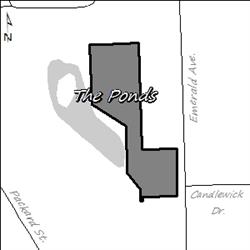
On a hot afternoon in June, I met with about 20 volunteers at The Ponds to celebrate National Trails Day. At the time, it did not seem like much more than a playground, picnic table, and small lawn enjoyed by neighbors. Now, with advocacy from Park Steward Shawn Severance and the help of those 20 volunteers, we have established a trail, making the natural area accessible to park users year-round.
When you visit The Ponds, you can find the beginning of the trail behind the playground between a couple of sumac stands. Once you round the corner and pass some buckthorn, you will find several eastern red cedars. Do not let the name confuse you, though, as this plant actually belongs to the juniper family. This time of year, red cedars are recognizable by their blue berries on the ends of their branches.
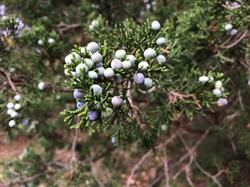
Berries on a red cedar
If you continue on the path beyond the red cedars and past a bit more buckthorn, you will eventually find a nice open canopy. There are a couple large black walnut trees within the open area and oaks, hickories, and maples along the edges. Raspberries and seasonal wildflowers make up the understory. Early autumn wildflowers include yellow goldenrod and New England asters. The final portion of the trail turns to the west and leads to the pond on the edge of the natural area.
Shawn Severance became a Park Steward because she wanted to create an easy route for families, such as hers, to access the playground from around the neighborhood. She shared some of her favorite things about the park with me:
The thing I noticed first about The Ponds was the lovely native hardwood diversity - red oak, sugar maple, black walnut, hickory - and despite colonies of buckthorn, in many places it's quite open with an abundance of fruiting black raspberry canes and other understory shrubs. It seems like it could be a nice small oasis for songbirds with the native understory. In an urban setting, a small 2.25 acre spot like the Ponds matters - when combined with Molin, Buhr, Mary Beth Doyle and County Farm Park it adds up to a mosaic that really can support foxes and owls, and that's something to be proud of.
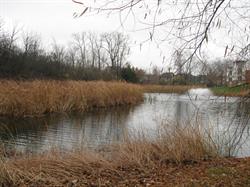
The pond adjacent to The Ponds Park
At the workday back in June, we put a lot of work into making The Ponds accessible to neighbors, but we are not done yet. I encourage you to cinch up your bootstraps, grab your warmest jacket, and join NAP on December 2 for another trail-building workday. We hope to continue the trail north to provide even more easy access to nature year-round.
Coordinators Corner: Creating Order from Chaos
Dave Borneman, Natural Area Preservation Manager
Since getting married this past summer, my wife and I knew that we needed a larger house than the one I’d been renting for the past seven years. So this fall, we bought a new house! Not far from the old one, but bigger, with plenty of room for everyone. Having my own truck and trailer, we could do the move ourselves, at our own pace, taking our time to get everything situated in the new house before bringing over another load.
At least, that was the theory. In reality, it takes a long time to get settled in a new place. More boxes needed to be moved in before the first ones were put away, and the big new house didn’t hold all the big new boxes very well, at least not very neatly. We quickly got bogged down in the chaos and disorder. For weeks we were moving boxes to make room for some piece of furniture, only to find that we needed to move them again to yet another temporary holding location in order to make room for something else.
It is sometimes like that with our ecological restoration projects. I remember, for example, when NAP first started working in Furstenberg Nature Area, before we had its official grand opening in 1995. The City had acquired the land as a park. A park sign was erected, a parking lot was installed, and trails were cut through the dense shrub thicket. I remember winding my way through the high-walled labyrinth of shrubs, trying to plan how we would tackle the immense amount of work that lay before us. The shrubs were so thick there was no place to put the ones we had cut. I remember mountains of piled brush out by the parking lot – cut, dragged out, and stacked by hundreds of volunteers so it could be chipped and hauled away.
After that Herculean task was accomplished, we patted ourselves on the back and moved on to the next site, only to discover that our work at Furstenberg was not done. The shrub thicket we had worked so hard to remove was growing back from the seedbank deposited over the decades. So we returned to the same site, this time with fire in hand, and followed that up with more shrub-cutting where the fire alone was not effective. We continued that treatment of fire and re-cutting for years, until we began to deplete the seedbank of exotic shrubs, and until the native grasses and wildflowers were established well enough to compete more successfully against the invaders.
Today, if you stroll through Furstenberg’s open oak savanna, and you see the carpet of Pennsylvania sedge and spring wildflowers, you might have a hard time imagining that it was once choked out by impenetrable thickets of buckthorn and honeysuckle. Just as, I’m hoping, future visitors to our spacious home will see no evidence of the jumble of moving boxes we have had to maneuver around this fall. Re-establishing a new home, just like re-establishing a lost ecosystem, requires time and patience.
Frogs in Winter: Amazing Adaptations
George Hammond, Field Biologist
When winter comes, the wildlife in our parks have many ways to keep warm. Some birds migrate south, living their lives in constant summer. Birds that stay use their feathers to keep warm, and rely on fat they stored in the fall. Many mammals spend the winter in burrows or nests, nibbling on stored food. Others tough it out and stay active, relying on warm fur and shelter to avoid the worst of the cold. Birds and mammals can keep themselves warm with fur or feathers, but amphibians don’t have this insulation. What do they do?
Only birds and mammals (and a few exceptional others) can generate heat in their tissues. Other animals such as reptiles and amphibians only get heat from the environment. They bask in the sun and get warmed by the air or water they are in, but can’t heat themselves. If the weather is cool, they’re cool. They’ve adapted to survive at a wide range of body temperatures. Their temperatures can rise or fall 10 degrees in a single day with no ill effects. They can warm up in the morning, cool overnight, and then warm again the next day. No problem in summer, but what about winter? It freezes here, and freezing is deadly!
Many reptiles and amphibians avoid freezing by retreating to places that stay just above freezing all winter. Salamanders and snakes find holes below the frost line. Toads dig themselves down deep. Turtles and many frogs spend the winter under water, on the bottoms of rivers and ponds. They can hold their breath all winter - the cold water slows down their metabolism, and what little oxygen they need they can get through their skin. One group of frogs has a tougher challenge. Small forest frogs, including spring peepers, gray treefrogs, chorus frogs, and wood frogs, don’t dig or swim. In winter they burrow down into leaf litter, but not far enough to escape frost. As the nights get colder, they do something amazing.
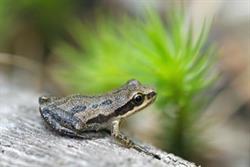
Chorus Frogs are one type of frog that freezes in the winter.
Photo Credit: Martha Hitchiner
In their body fluids, outside their cells, these frogs have proteins that cause ice crystals to form at a lower temperature than inside the cells. The water in the blood and body cavities starts to slowly freeze. Salts and other molecules in the fluids are left out of the ice crystals, causing the remaining fluid to become salty and concentrated. Normally this would draw lots of water out of nearby cells, dehydrating and killing the cells. However, as it freezes, the frogs flood glucose (sugar) and other chemicals into their cells. These chemicals act as natural antifreeze. The high concentrations of sugar in the cells keep the water from diffusing out, preserving the cells. The body fluids continue freezing outside the cells but not inside. Ice crystals form in the gut and veins and arteries. The frog stops breathing. As the freezing continues, the heart keeps beating and the liver pushes out more antifreeze. Eventually ice reaches the heart, and it stops. The cells of the frog, partially dehydrated, still (barely) function, but each on its own, with no communication. The frog is inert, no pulse, no breathing, no motion of any kind. Outside the cells there is solid ice all through the frog. As much as two-thirds of the water in the animal freezes solid. If you drop one of these frog-cicles on a hard surface, it clinks!
These frog species can survive temperatures below freezing for many weeks this way. When spring comes and the temperature warms, they quickly thaw out and revive. Within a day the frog can move around, and head directly to a seasonal pond to breed. What an amazing adaptation to get these frogs through the cold winter!
If you’d like to get to know the wonderful amphibians of Ann Arbor, consider volunteering with our frog or salamander surveys. The survey kick-offs and trainings are March 3.
NAPpenings
Welcome new Park Stewards!
Rick Berry
Mary Beth Doyle Park
Emily Rosen
Barton Nature Area
David McAlpine
Mary Beth Doyle Park
Brian Tolle
Marshall Nature Area
Thanks and congratulations to these Boy Scouts who completed their Eagle Scout projects in our parks:
Rishi Nemorin
Wayfinding Posts at Mary Beth Doyle Park
Calvin Floyd
Boardwalk at Mary Beth Doyle Park
Thank you!
Many thanks to the groups who volunteered with NAP recently. We could not make such a difference without you!
Alpha Phi Omega, UM
Ann Arbor Boy Scout Troop 8
Ann Arbor STEAM
Circle K, UM
Cub Scout Pack 22
Delta Sigma Pi, UM
Delta Zeta, EMU
EMU VISION
EMU Wetland Ecosystems Class
Friends of Dicken Woods
Huron High School
Michigan Community Scholars Program
MRUN
M-STEM Student Council
NSF International
Phi Rho Alpha
Rotaract
SBD North America
Sigma Delta Tau, EMU
Sigma Gamma Tau, UM
Skyline Environmental Club
Telluride Association
UM Dental School
UM Ducks Unlimited
UM Ecological Issues Class
UM Engineering Global Leadership
UM Graduate Rackham International
UM Rackham Student Government
UM School of Information
Volunteer Union
Washtenaw Audubon Society
WCC Office of Student Organizations
Thank you to the local organziations that donated prizes for our Volunteer Appreciation Potluck!
Fairytale Baked Goods
www.facebook.com/bakedfairytales
Huron Hills Golf Course
www.a2gov.org/golf
Leslie Science and Nature Center
www.lesliesnc.org
Moosejaw Ann Arbor www.moosejaw.com
Motawi Tileworks
www.motawi.com
Planet Rock Climbing Gym www.planet-rock.com
Radius Garden Tools
www.radiusgarden.com
UM Adventure Leadership https://recsports.umich.edu/trips/
Conferences Sponsored by NAP
The Stewardship Network
The Science Practice, and Art of Restoring Native Ecosystems Conference
January 12-13, 2018
The Stewardship Network presents this annual conference at the Kellogg Conference Center at Michigan State University in East Lansing. Presenters cover a wide range of topics including environmental justice, watershed conservation, and much more! See
www.stewardshipnetwork.org to register or for more information.
2018 Buring Issues Workshop
February 6-7, 2018
Presented by:
Lake States Fire Consortium, Michigan Prescribed Fire Council, Tallgrass Prairie and Oak Savanna Fire Science Consortium, Michigan National Guard
This annual wildland fire workshop explores topics that are relevant to those working with fire across the state of Michigan and the Upper Midwest. It takes place at Fort Custer National Training Center in Battle Creek. See lakestatesfiresci.net to register or for more information.
Staff Updates
Farewell
 Patrick Terry, Herpetologist
Patrick Terry, Herpetologist
During the last three and a half years, I've met many people to whom I owe a debt of gratitude. To my colleagues and supervisors, thank you for giving me the opportunity to learn and grow as a professional. To the herpetology volunteers, thank you for your passion! I am moving to Arizona with my fiancee, to work as a Pronghorn Biologist in the Sonoran Desert. Goodbye everyone! It has been a pleasure working with all of you to protect and restore Ann Arbor's natural areas. I will treasure my time with you at NAP for the rest of my life.
Welcome
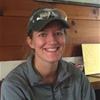 Anna Tawril, Field Crew
Anna Tawril, Field Crew
I'm excited to join the NAP team as a Conservation Worker! I graduated from the University of Michigan with a degree in Environmental Science and Sustainable Food Systems. In the past I have worked on a trail crew in Tennessee and on sand dune restoration in northern Michigan. I am excited to spend more time in Ann Arbor's parks and getting to know the volunteers. It's great to work in an area full of people who understand the importance of conservation. My passion for restoration stems from my love of the outdoors and the desire to share it with others, which I have lots of opportunities to do at NAP!
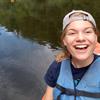 Liz Berghoff, Field Crew
Liz Berghoff, Field Crew
This summer, I graduated from Eastern Michigan University with a degree in Environmental Science. Before joining NAP, I worked with GIVE 365 where my love of Ann Arbor parks and leading volunteer groups began. I spent the summer interning with the Southeast Michigan Land Conservancy where I was able to gain experience monitoring and maintaining nature preserves. I enjoy exploring all the natural areas Michigan has to offer and petting as many dogs as I can along the way. I'm excited to learn more about land conservation and lead volunteers in meaningful work.
Would you like to be part of the NAP Staff team? Follow the city jobs website (a2gov.org/jobs). Positions can open throughout the year.
NAP also has unpaid internships that provide valuable experience! For internship information contact NAP directly: [email protected] or 734.794.6627.
NAP by the Numbers: Highlights of 2017
2,255 Volunteers worked over 9,228 hours in 2017!
Our crew managed invasive species on 318 acres in 45 parks.
We held 48 Public Workdays and 48 Private Workdays.
32 Breeding Bird Survey volunteers spent 380 hours observing birds in 33 parks. Since 1990, 237 species have been seen in city parks. We added 1 new species this year: Baird’s Sandpiper.
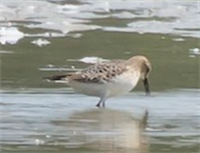 Baird's
Sandpiper
Baird's
Sandpiper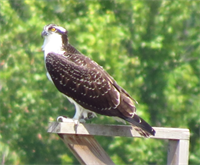 Osprey
Osprey
Frog, toad, and salamander survey volunteers gave 425 hours this year, and observed 21 species of amphibians and reptiles in our parks.
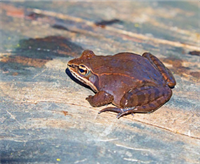 Wood Frog
Wood Frog
Butterfly survey volunteers gave 64 hours and observed 37 species in 7 parks.
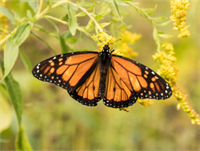 Monach Butterfly
Monach Butterfly
We had our first-ever bat survey in partnership with the Organization for Bat Conservation. Volunteers contributed 11 hours.
HELP US GROW!
Volunteers help us keep track of the plants and animals in our nature areas. Check the calendar inside for the survey training and kickoff events coming in early spring. We would also be delighted to have you come to our public workdays, or contact us about organizing a private workday for your group!
